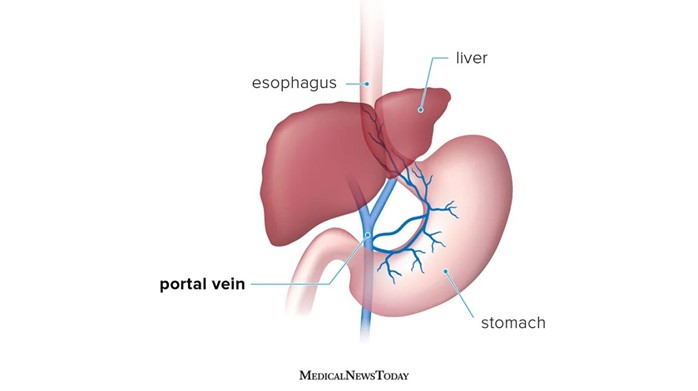A nurse caring for a client with hepatitis is providing education to the client about portal hypertension. Which of the following will the nurse include in the teaching?
"Increased pressure from portal hypertension contributes to the abdominal swelling."
"Portal hypertension is caused by the heart overworking."
"Portal hypertension develops when the cirrhosis begins to resolve."
"Eating high sodium foods and a stressful lifestyle contribute to portal hypertension."
The Correct Answer is A
Choice A reason: This is the correct answer because portal hypertension means that there is high blood pressure in the portal vein, which carries blood from the digestive organs to the liver. When the liver is damaged by hepatitis, it becomes scarred and obstructs the blood flow, causing increased pressure in the portal vein. This leads to fluid accumulation in the abdomen, called ascites, which causes abdominal swelling.
Choice B reason: This is incorrect because portal hypertension is not caused by the heart overworking but by liver damage. The heart does not pump blood into the portal vein, but into the hepatic artery, which supplies oxygenated blood to the liver.
Choice C reason: This is incorrect because portal hypertension does not develop when cirrhosis begins to resolve, but when it progresses. Cirrhosis is a chronic condition that causes irreversible scarring of the liver tissue, which worsens over time and increases portal hypertension.
Choice D reason: This is incorrect because eating high-sodium foods and a stressful lifestyle do not cause portal hypertension, but they can aggravate it. High-sodium foods can increase fluid retention and worsen ascites, while stress can increase blood pressure and worsen bleeding complications. The nurse should advise the client to limit sodium intake and manage stress levels.

Nursing Test Bank
Naxlex Comprehensive Predictor Exams
Related Questions
Correct Answer is A
Explanation
Choice A Reason: This is correct because macular degeneration is a condition that affects the macula, which is the central part of the retina that is responsible for sharp and detailed vision. Macular degeneration can cause blurred or distorted central vision, difficulty reading or recognizing faces, or dark spots in the visual field.
Choice B Reason: This is incorrect because glaucoma is a condition that affects the optic nerve, which is the nerve that connects the eye to the brain and carries visual signals. Glaucoma can cause increased pressure inside the eye, damage to the optic nerve, and loss of peripheral vision.
Choice C Reason: This is incorrect because diabetic retinopathy is a condition that affects the blood vessels in the retina, which is the layer of tissue at the back of the eye that converts light into nerve impulses. Diabetic retinopathy can cause bleeding, swelling, or leakage of fluid in the retina, and loss of vision in any part of the visual field.
Choice D Reason: This is incorrect because cataract is a condition that affects the lens, which is the transparent structure behind the pupil that focuses light onto the retina. Cataract can cause clouding or opacity of the lens, and reduced vision in all parts of the visual field.
Correct Answer is D
Explanation
Choice A Reason: Providing written materials and visual aids is not necessary for a client who has hearing at 15 dB, which is considered normal hearing. Normal hearing ranges from 0 to 20 dB, meaning that the person can hear sounds that are as faint as 20 dB or less.
Choice B Reason: Using American Sign Language is not appropriate for a client who has hearing at 15 dB, which is considered normal hearing. American Sign Language is a form of communication that uses hand gestures, facial expressions, and body movements to convey meaning. It is mainly used by people who are deaf or hard of hearing.
Choice C Reason: Shouting at the client from 6 inches away is not advisable for a client who has hearing at 15 dB, which is considered normal hearing. Shouting can be perceived as rude or aggressive, and can damage the hearing of both the speaker and the listener.
Choice D Reason: Speaking to the client in an everyday conversational tone is the best action for a client who has hearing at 15 dB, which is considered normal hearing. Conversational speech ranges from 40 to 60 dB, meaning that the person can hear sounds that are as loud as 60 dB or less.
Whether you are a student looking to ace your exams or a practicing nurse seeking to enhance your expertise , our nursing education contents will empower you with the confidence and competence to make a difference in the lives of patients and become a respected leader in the healthcare field.
Visit Naxlex, invest in your future and unlock endless possibilities with our unparalleled nursing education contents today
Report Wrong Answer on the Current Question
Do you disagree with the answer? If yes, what is your expected answer? Explain.
Kindly be descriptive with the issue you are facing.
